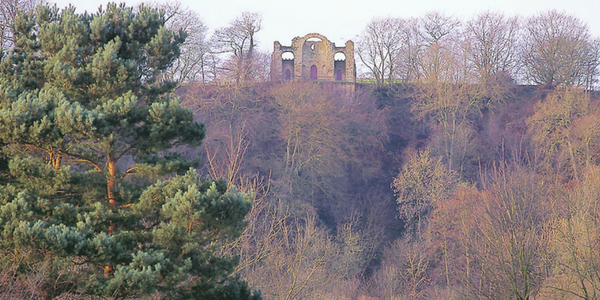 William Beckford (left) and William 'Kitty' Courtenay (right)
William Beckford (left) and William 'Kitty' Courtenay (right)
William Beckford, who died on 2 May 1844, was a troubled and troubling figure. Rich beyond dreams since boyhood, precociously brilliant, charming and handsome, creative and discerning, Beckford was also gay.
Beckford cast his glamorous spell over three main places: Monserrate in Portugal (in flight), Fonthill Abbey in Wiltshire (in extravagant solitude at the Gothick extravaganza he built on the family estate) and Beckford’s Tower, above his last home in Lansdowne Crescent, Bath. That there is now a Landmark at Beckford’s Tower is well known, but what is less well known is an association between Beckford and another Landmark, The Ruin at Hackfall in Yorkshire.

Fonthill Abbey in Wiltshire
Why a troubled figure? Because sodomy in Regency Britain was a capital offence. To be queer in Beckford’s day was to risk the gallows, stakes greater even than those faced by Oscar Wilde in his own humiliation a century later. Beckford was a similarly charismatic and flamboyant figure, but unlike Wilde, his enormous wealth mostly allowed him to escape from, and cocoon himself against, society’s censure. He both threw wild parties and lost himself in literature and connoisseurship, but always defined himself in melancholy contradiction to the society he saw around him.
And why a troubling figure? Because in 1779, when he was 18, Beckford fell in passionately in love with the Honourable William Courtenay, later 3rd Viscount and 9th Earl of Devon. Kitty, as Beckford nicknamed the beautiful boy, was then ten years old. Beckford swung between emotions of elation and despair; he also confided his feelings to Kitty’s aunt Charlotte (who promptly fell in love with Beckford herself) and his drawing master Alexander Couzens. ‘I grew sensible that there was pleasure in loving something besides myself’, he wrote to Couzens.
Rashly, Beckford also made no secret of his infatuation for Kitty in the Courtenay and Beckford households. The immediate result was that he was despatched to the Lake District with his long suffering personal tutor, the Reverend Lettice, to cool his ardour. It was during this tour, on 29th September 1779, that Beckford visited Hackfall, where William Aislabie had recently created of the most renowned Picturesque landscapes of the day. The folly known as The Ruin (now a Landmark) was the site’s climax, offering spectacular views across the ravine of the River Ure to the Vale of York.
 The Ruin at Hackfall in Yorkshire
The Ruin at Hackfall in Yorkshire
The youth kept a journal of his tour, and this unpublished document, Fragments of an English Tour, is now at the Bodleian Library in Oxford (MSS Beckford, d.3 1779). The still adolescent Beckford gives his considerable literary powers full rein in his descriptions of the place, and, lovestruck, is solitary and luxuriantly melancholy. It’s also hard to escape the impression that he is writing his journal as a description for an intimate friend - Kitty?
‘Beds of Moss carpet the edge of the Waters softer and more delicious than I think ever rivulet enjoyed. I need not tell you that I reposed upon them, poring over the Brook according to my old Custom and prying into the Copses where it lost itself in depths and hollows and gurgled unseen. These are truly Haunts for rural Powers – Springs and Fountains over which the Naids [sic] need not blush to preside.’
And:
‘I came to a spot darkly shaded by Oaks overgrown with Ivy and Mistletoe, strewed with dried leaves and so strangely hemmed in by misshapen roots that I could not help thinking I was entering the Domain of a Wizard. The Rustling of my footsteps amongst decayed leaves disturbed the devotions of a solemn Owl (perhaps the Wizard himself) who sat moping in the hollow of an Oak. He opened a very suspicious Eye upon my approach and sailing away over the Vale beneath hid himself in the distant solitude.’
True, Beckford does not recount that he visits The Ruin, but he cannot have visited Hackfall by carriage as he did without encountering it.
As for his relationship with Kitty, it developed into a fully consummated affair over the next five years, persisting beyond Beckford’s Grand Tour. Circulating rumours became full scale scandal when the pair were apparently found caught in flagrante at Powderham Castle in 1784. Beckford , by now married, refused to admit guilt, claiming he had merely been thrashing the boy (this, it seems, would have been perfectly acceptable).
Kitty, however, was forced to confess and surrendered various letters. George III said he wished Beckford had been hanged but no prosecution was brought. In 1785, Beckford and his wife (to whom he was also devoted and who died soon after) departed for the Continent. It would be seven years before William Beckford returned to England for more than fleeting visits, for the next chapter in this colourful life.

‘We left York on a sunny day…’ Beckford’s journal entry for 29 September 1779